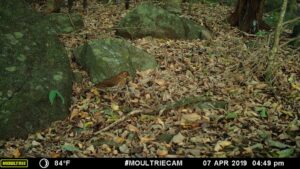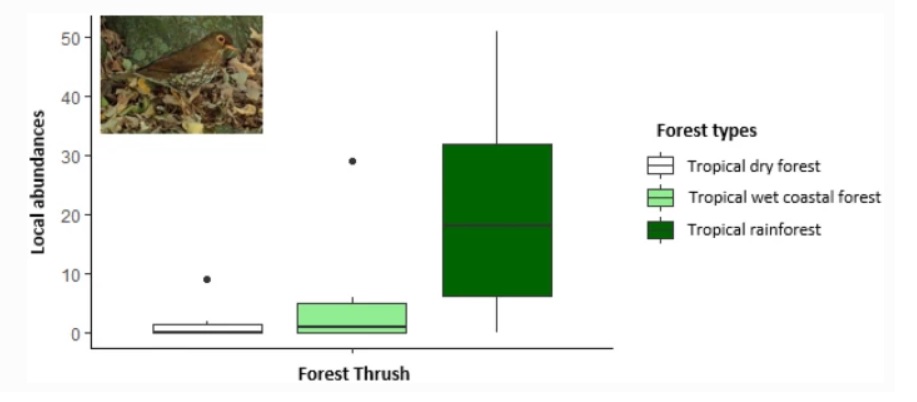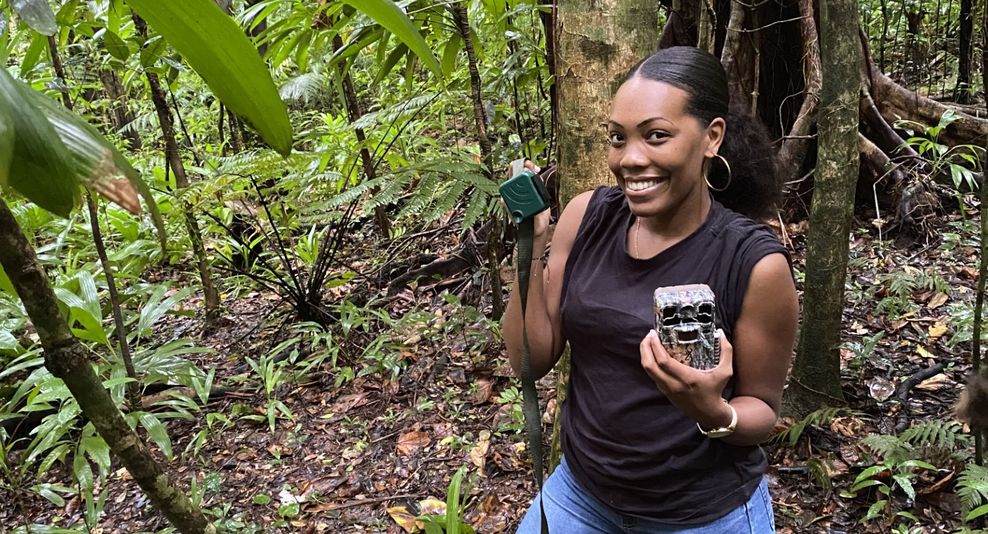The Forest thrush, Turdus lherminieri, is an endemic bird of the Lesser Antilles. This species, which harbours a distinctive plumage and sings melodious song, feeds on the ground, searching the litter with its beak for insects and other invertebrates. Already rare, as it is found only on four islands in the Caribbean, the species is now potentially threatened by deforestation, the introduction of exotic species and hunting.
A study recently published in the international journal European Journal of Wildlife Research investigated the factors that explain variations in the presence and abundance of the Forest Thrush in Guadeloupe. To this end, camera traps were deployed in 24 sites, spread over the islands of Guadeloupe, Basse-Terre and Grande-Terre. These instruments, positioned about twenty centimetres above the ground, have the advantage of being automatically triggered when an animal passes in front of the lens. Operating day and night, they can be used for weeks to observe wildlife without disturbing it.

Forest thrush captured with camera traps
In total, almost 10,000 photos were taken, 330 of which concerned the species studied. Using statistical analyses, the authors of the study were able to assess the occupancy and abundance patterns of the Forest Thrush in different forest areas of Guadeloupe, taking into account various environmental variables: forest type, degree of canopy openness, temperature and altitude.
The study revealed a clear preference of the species for rainforests, with a much higher presence and abundance than in dry or coastal forests. The probability of observing the species increases with the degree of canopy closure, while its abundance decreases with increasing ambient temperature. The species therefore seems to prefer cool, shady undergrowth for foraging.
Using data collected continuously with camera traps, the authors were also able to estimate the degree of overlap between the distribution of thrushes in space and time and that of their potential predators. The results show that thrushes and stray cats are rarely found in the same places, although the reason for this cannot be determined at this stage. It could be both that thrushes avoid areas where stray cats are abundant, and that cats locally reduce thrush numbers through predation. Further studies on the diet of stray cats are therefore needed to fully assess the potential threat posed by stray cats.

The local abundance of the species depends of the type of forest
Understanding the factors influencing the spatial occupancy and abundance of the Forest Thrush in Guadeloupe can help develop effective conservation strategies to protect the species in the face of ongoing threats to its habitat. At present, although the species is considered near-threatened by the IUCN, the present study indicates that Guadeloupe’s populations are doing rather well. This positive result could be linked to the regulation of hunting, implemented in 2014, but also to the almost total protection of the Guadeloupe tropical rainforests.
Reference
Jean-Pierre, A., Loranger-Merciris, G., Saint-Louis, L.J. & Cézilly, F. (2023). Factors affecting spatial occupancy and local abundance of the Forest Thrush, Turdus lherminieri, in Guadeloupe forests. European Journal of Wildlife Research 69: 76.
About the author
Aurélie Jean-Pierre is currently pursuing her doctorate research at the Université des Antilles (Guadeloupe), under the supervision of Prof. Gladys Loranger-Merciris. Her research on the impact of environmental factors on the presence and relative abundance of several species of birds is co-financed by the Ministry of Higher Education, the NGO Caribaea Initiative and the Office Français de la Biodiversité (OFB).

